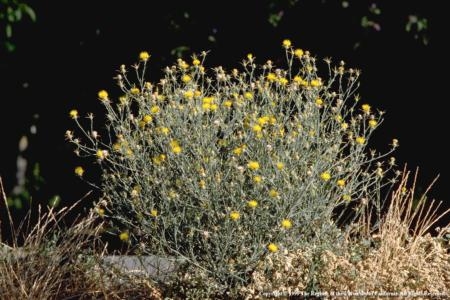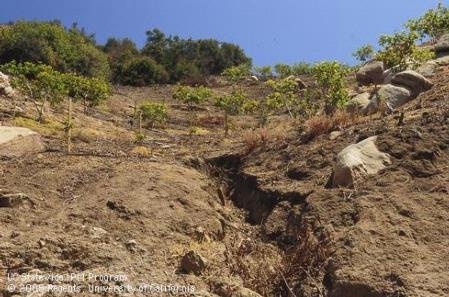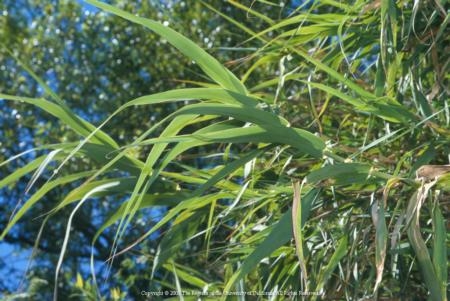Posts Tagged: erosion
Collaboration may be an effective way to fund wildland weed control
Many funding sources for weed eradication have been reduced or completely eliminated. According to the California Assembly Budget Committee’s annual Preliminary Review of the Governor’s Proposed 2012-13 State Budget, the California Department of Food and Agriculture will absorb a permanent budget reduction of $12 million in program cuts, in addition to a $19 million budget reduction in 2011-12. Funding for weed management areas (WMAs) has been reduced to the point that many WMAs have become inactive or are being managed voluntarily as an adjunct to other duties.
At the California Invasive Plant Council (Cal-IPC: http://www.cal-ipc.org/) annual symposium at Lake Tahoe in October, it was stressed that competition for limited funding will pit us against ourselves and each other. Only by working together, creating collaborative projects, will we be able to benefit from the limited funding opportunities available.
Enter the collaborative grant-funded project. Agencies are looking for applications that demonstrate community support from a diverse range of stakeholders. For example, the Sierra Nevada Conservancy (SNC) is currently reviewing proposals received in response to their Healthy Forests initiative. Proposition 84 — The Safe Drinking Water, Water Quality and Supply, Flood Control, River and Coastal Protection Bond Act of 2006 — will fund approved projects. Five million dollars is available this year for healthy forest projects; next year an equal amount will be available for rangeland projects.
Two weed control projects created by UC Cooperative Extension Central Sierra received SNC invitations to submit complete grant applications. One project is a collaboration between UCCE, the U.S. Forest Service, and Yosemite National Park; another works in partnership with Cal-IPC.
As an example of the collaborative partnerships being sought by funding agencies, the National Fish and Wildlife Foundation is offering the ‘Pulling Together Initiative’ which “seeks proposals that will help control invasive plant species, mostly through the work of public/private partnerships such as Cooperative Weed Management Areas.” Successful projects must “have a project Steering Committee composed of local cooperators who are committed to working together to manage invasive and noxious plants across their jurisdictional boundaries.”
Clearly, in light of decreased federal and state funding, a strategic direction for weed-control projects will be to leverage resources, working together to do what no one agency can accomplish alone.
Two additional collaborative projects, created by Wendy West of UCCE Central Sierra, are highlighted here:
- A Weed-Free Forage List providing California resources for weed-free feed and erosion control materials will soon be posted on Cal-IPC’s website. The site will also contain explanatory information about weed-free certification, along with links to inspection procedures and noxious weed lists.
- Workshops designed to help prevent the spread of weeds during construction, aggregate production and maintenance activities are being offered throughout the state. The workshop is hosted and sponsored by U.S. Forest Service, National Park Service, California Department of Food and Agriculture, University of California and University of Nevada Cooperative Extension, and the California Invasive Plant Council.
A Fresno County workshop was held in January and a sold-out workshop is scheduled for March in Los Angeles County. If you are located in the central California region that includes Amador, Calaveras, El Dorado, Madera, Mariposa, San Joaquin, Stanislaus or Tuolumne counties, please consider attending the next workshop, scheduled for April 9 in Sonora. The final workshop will be held in Truckee on May 2. Register for the workshops here.
Prevention Workshop 2012 flier
Workshop Schedule.Agenda
Understanding soil erosion in irrigated agriculture
Soil erosion threatens our ability to feed ourselves in the future. Current concerns regarding soil erosion include economic vitality, environmental quality and human health.
How can losing a little soil to erosion be such a concern? Soil formation is a very slow process. It takes nature between 300 to 1,000 years to replace soil lost over a 25-year period at a loss rate of 1 mm per year (25 mm is approximately 1 inch)
Erosion reduces the productivity in several ways: Plants are not able to use nutrients as efficiently, seedlings are damaged, rooting depth is decreased, soil’s water-holding capacity is diminished, permeability is decreased, runoff increases and the infiltration rate declines. The loss of healthy soil leads to poor plant growth and lower crop yields.
In the United States we lose an estimated 6.9 billion tons of fertile topsoil to erosion each year. Losses of this size are far from sustainable. In an effort to continue food production, costly fertilizers and amendments are used to compensate for the lost soil. The loss of nutrients alone is estimated to cost U.S. farmers $20 billion a year.
As runoff carries sediment, nutrients, and agricultural chemicals off-site, the economic and environmental costs skyrocket.
The University of California has resources to help reduce the loss of soil through erosion. The free, five-page publication Understanding Soil Erosion of Irrigated Agriculture provides information to help maintain the productivity of land and reduce the enormous costs associated with erosion.
Topics include:
- Impacts of soil erosion
- Types of water erosion
- Indicators of soil erosion
- Soil survey interpretations
- Land capability classification system
- Soil erosion factors
- New soil survey resources
Additional resources, can be found at the UC ANR free publication website.
Invasive reed arundo is choking state waterways
In the early 1800s, European immigrants introduced the fast-growing giant reed arundo (Arundo donax) into California to use the canes for musical instruments. The plants were also used for erosion control and the reeds used for thatched roofing. However, it has since naturalized and become a serious pest in the state's natural waterways.
Arundo can grow at a rate of four inches per day and can reach heights of 30 feet. It reproduces and spreads when sections of the stem or root break off and float downstream.
Dense stands of arundo displace native riparian species. The plant requires a significant amount of water, reducing fish, wildlife and people. In addition, clumps of arundo and the soil around their roots can break off, causing streambank erosion. The clumps can also create channel obstructions that lead to flooding.
Arundo is highly flammable and can quickly carry fire along waterways. After a fire, arundo quickly grows back from its roots. With other nearby plants burned by fire, arundo can spread even more quickly, leaving no room for native plants to recover.
Californians can help reduce the spread of arundo by taking the following actions:
- Learn more about arundo, including how to identify it
- Report sightings to local conservation groups
- Join local eradication efforts or help to start one
- If you own land with an arundo infestation, request help and provide access for control efforts

arundo




